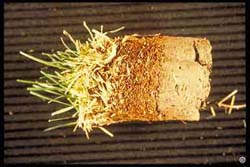Thatch is a common problem on bluegrass lawns that contributes to brown spots and general thinning.

Thatch is the spongy, brown layer of organic matter found between the leaf zone and the soil. If it’s more than one-half inch thick, it’s important to reduce thatch buildup.
Leaving grass clippings on the lawn does not contribute to thatch buildup. In fact, it’s an environmentally responsible way to recycle nutrients and dispose of lawn clippings.
The primary factor leading to thatch problems is soil compaction. Thatch problems are very common on newer sod laid over clay-type soils. Other factors include excessive nitrogen fertilization, infrequent mowing, and vigorously growing turf varieties. Some lawn pesticides also contribute to thatch build-up, so avoid unnecessary use of these chemicals.
To reduce thatch and compaction, aerate the lawn. Make enough passes with the aerator to make plug holes which should be two to three inches deep and no more than two to four inches apart. Lawn aerators are readily available from local rental firms and are about as easy to use as a lawn mower. When using aerators, be careful not to puncture shallow irrigation systems.
Because fewer weed seeds germinate in the fall, it’s best to aerate between late August and late September. Where compacted soils or thatch is a problem, it may be helpful to aerate in spring and fall.
For maximum effect, leave the plugs on the lawn surface for a few days to allow rain and irrigation water to wash the soil from the plugs. The remainder of the plugs then can be picked up if desired.
For more information, see the following Colorado State University Extension fact sheet(s).



